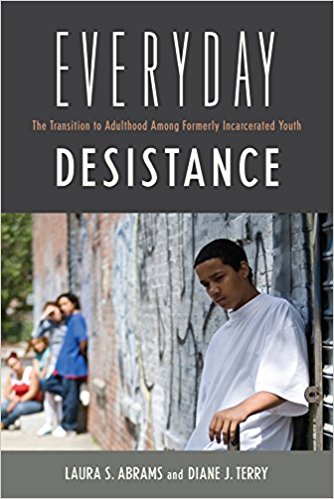
Everyday Desistance: The Transition to Adulthood Among Formerly Incarcerated Youth | Laura S. Abrams and Diane J. Terry | Rutgers University Press | May 31, 2017 | 256 pages
“We are marked. Forever. All of us. No matter how much the transformation.” —Oscar
“Everyday Desistance: The Transition to Adulthood Among Formerly Incarcerated Youth” sheds a critical light on the winding journeys into adulthood of 25 formerly incarcerated young adults ages 18 to 24 in Los Angeles County. Their work is based on stories that speak powerfully to the societal failures that lead children into the juvenile justice system and is thought-provoking, stirring and bold.
The authors shatter our illusion that individuals can turn their lives around simply through sheer will. Instead they speak to the complexities of life in desistance; they reveal the multiple deep layers that a young man or young woman must overcome to embrace their new path. An example of this is the overwhelming shadow of fear young people face when leaving the protection of a gang. Without this protection, they are isolated from friends and family and often marked and vulnerable for attack. This is counterintuitive for many of us who have never lived within these frameworks, but for them it is an everyday choice: to stay in a gang and continue their old way of life under protection or face life alone.
In urban Los Angeles, an environment defined by extremes of wealth, race discrimination, education and health access, we follow these young people as they become young adults trying to survive and make it on their own. We follow their everyday triumphs and challenges, and we glimpse the frustration they live with knowing there is never one clear fresh start.
Daily, they face the same confrontations with law enforcement, lack of familial and community support and access to financial resources, employment and stable housing that led them down the path to incarceration from the very beginning. They also carry the scars of juvenile system involvement and a criminal record. As Oscar said, even if the scars can heal, the marks of their childhoods remain.
With this reality, it is not surprising that the path to reintegration and success in the community is rarely linear; it winds through good intentions, setbacks, disappointment, barriers and ultimately hope and determination. The book also pays thoughtful attention to the unique challenges of young women who are searching for a stable base when the idea of home had already eluded them for a long time.
For Irene, the question of survival loomed large when she came home. The authors describe how, after five years of incarceration, Irene left California Youth Authority with $5 in her pocket and a small bag of belongings from when she was 15. In grave situation like these, the pressure on young women to resist crime when facing homelessness and hunger can seem insurmountable.
Finally, while many other books and papers focus on unique case studies of either the extreme failure or extreme success of a young person transitioning from juvenile justice involvement into adulthood and hold these examples up to be the norm, this book takes a different approach. It opens our eyes to the young people who don’t fit the sound bites, those who go through life’s ups and downs and end up stronger, and it pays tribute to their resilience and ability to dream big despite the odds.
This book is a must read for anyone looking to understand the complex daily choices of desistance and to support formerly incarcerated young people to not only survive in adulthood but also to thrive. For me, the book goes beyond the confines of juvenile justice readership — it holds important lessons for anyone working in child welfare to consider their work in the larger picture of poverty, community, incarceration and reentry.
Many of these adults were once children who never seemed to have a chance, facing multiple personal and structural traumas while being labelled, judged and punished from an early age. We must ask ourselves the difficult question of how can I help stop this cycle early and often.
Aiasha Khalid is deputy director-strategy & impact at Root & Rebound: Reentry Advocates.
Great review!